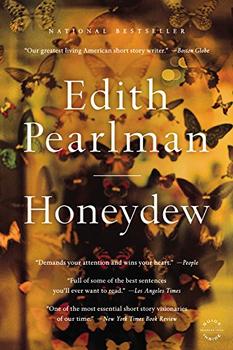Summary | Excerpt | Reviews | Beyond the Book | Readalikes | Genres & Themes | Author Bio

Stories
by Edith PearlmanTenderfoot
Tenderfoot was a pedicure parlor on Main Street near Channing. Two reclining chairs?—?usually only one was in use?—?faced the street through a large plate-glass window. And so customers, alone with Paige, got a kind of public privacy?—?anybody could see them, no one but Paige could hear them. Paige was an expert listener?—?rarely commenting on what she heard, never repeating it.
She was a widow, forty-nine and childless. She lived behind and above her store. She played poker with five other women every Saturday night. They called one another by their last names and smoked cigars. She had lost her husband, a talented mechanic, to the war. Carl was in favor of the war, more or less; but he'd joined up mainly to get further mechanical training at the military's expense. She'd objected to his risking their joint future, their happiness . . . but she'd let the argument drop. The Marines took him despite his age. And then, three days into the desert, the tank he was riding met a mine. Each of his parts was severed from the others, and his whole?—?his former whole?—?was severed from Paige.
Paige's practice expanded. She had always been popular with faculty wives and local lawyers and dentists, who appreciated that a footbath administered by a discreet attendant squatting on a stool could become a kind of secular confessional. Now, perhaps because of her recent sad history, she caught on with booksellers and high school teachers and nurses. They discovered how easy she was to talk to. Doctors sent patients to her, elderly women who could no longer bend down to clean their feet, could no longer clip their own toenails. Elderly men too?—?their joints were as stiff as their wives'.
That fall?—?the fall of Bobby Farraday's arrival at the college to teach art history?—?other male clients began to appear, not sent by their doctors. A professor emeritus of physics was the first. Then another professor, not emeritus. The high school principal, in a fit of bravado, had his toenails painted raspberry sherbet, chattering all the while.
Bobby had rented rooms ideal for someone newly separated with no interest in changing his circumstances. He hung the engravings that had been his, not Renée's, in the living room and the narrow one-bedded bedroom. The tiny kitchen was just big enough for him and an unseen resident mouse. These rooms and kitchen were on the second floor of a Victorian, and the bathroom occupied the whole of the third-floor turret. The house happened to be located on Channing Street near its intersection with Main, which put it more or less diagonally opposite Tenderfoot. Bobby and Paige often ran into each other in the early evening?—?at the vegetarian market, at the newspaper and tobacco kiosk, at the bookstore. Sometimes they talked, as neighbors do.
Secretly he considered himself more than her neighbor. He was her invisible housemate, as the mouse was his. His high bathroom had a broad curtainless window next to the toilet. The window gave him an angled view of the work space of the pedicure shop and a bit of Paige's living area. He took advantage of his situation. Sometimes he stood to watch the pedicures, but usually he sat on the lidded toilet, like a peep-show connoisseur. He liked to see the customers relax on the chair, as if this quasi-biblical experience transported them to some soapy heaven; as if, briefly dead, they could call their sins forgiven. Or maybe they were just happy to have a chance to kick off their shoes and talk about their troubles.
He conducted his classes, showed his slides, met with students during his office hours. He found the teaching and the kids distracting. One of the blond young women reminded him of Renée?—?knowledgeable on the outside, unsure on the inside. But even inviting a student to take in a movie was forbidden; and so he hurried away from his office hours to watch, alone, the blameless performance on Main Street.
Excerpted from the book Honeydew. Copyright © 2015 by Edith Pearlman. Reprinted with permission of Little, Brown and Company. All rights reserved.
Your guide toexceptional books
BookBrowse seeks out and recommends the best in contemporary fiction and nonfiction—books that not only engage and entertain but also deepen our understanding of ourselves and the world around us.